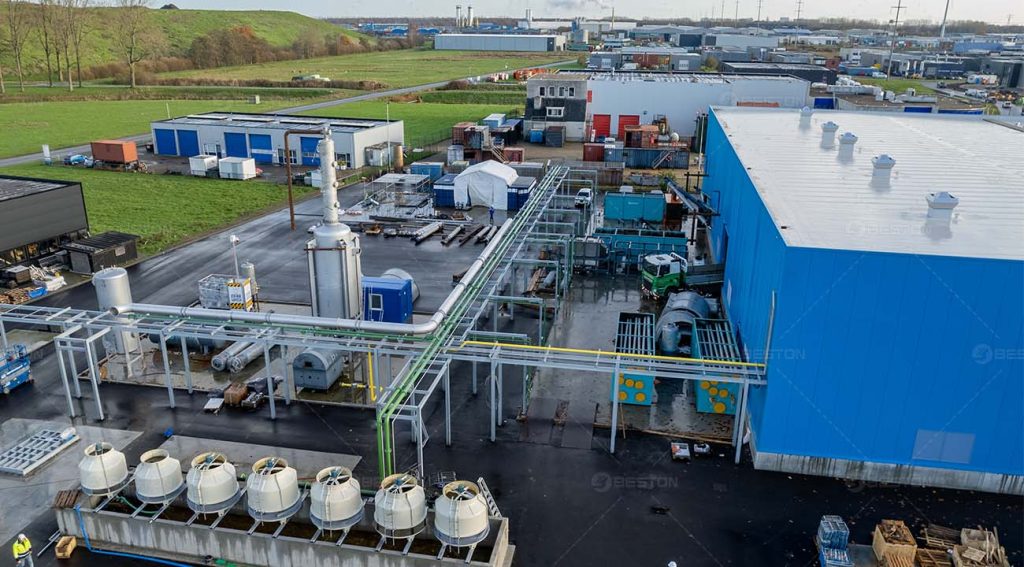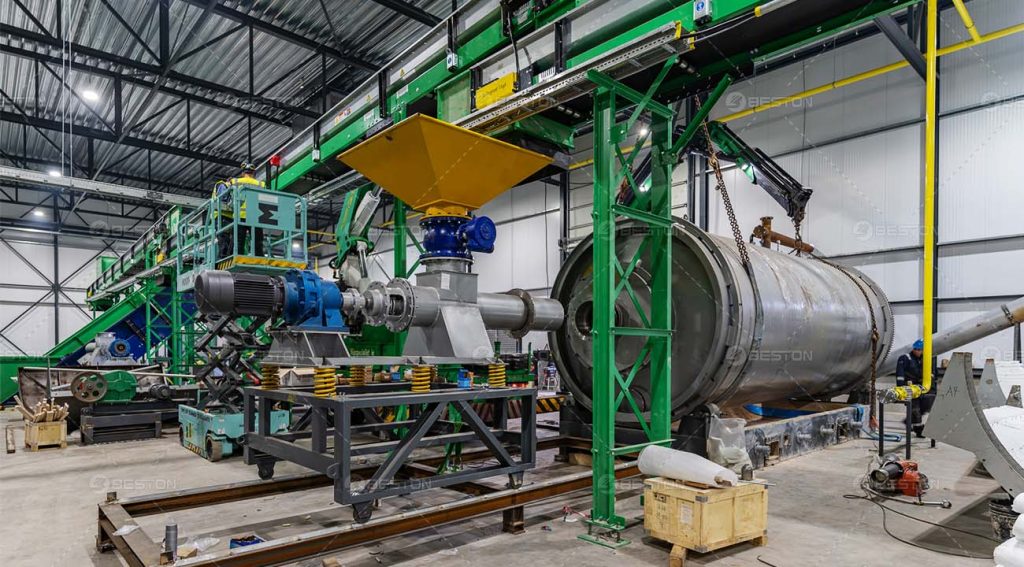What is a Plastic Pyrolysis Plant
Plastic waste has become a pervasive environmental challenge, polluting landfills and oceans, and posing a threat to ecosystems worldwide. In the pursuit of effective waste management solutions, the emergence of plastic pyrolysis plants offers a glimmer of hope. A plastic pyrolysis plant is a sophisticated facility designed to convert plastic waste into valuable products through a thermal decomposition process. In this article, we explore the inner workings of plastic pyrolysis plants, their benefits, challenges, and future prospects.

Waste Platic Pyrolysis Plant
Working Principle of a Plastic Pyrolysis Plant
At the heart of a plastic pyrolysis plant lies the principle of thermal decomposition. This process involves subjecting plastic waste to high temperatures in the absence of oxygen, triggering chemical reactions that result in the conversion of the plastic into useful byproducts.
Within the plant, a reactor vessel serves as the core component, providing the controlled environment necessary for the thermal decomposition process. The plastic waste is fed into the reactor vessel, where it is heated to temperatures ranging from 300 to 500 degrees Celsius. The absence of oxygen prevents the plastic from combusting and instead initiates thermal cracking.
As the plastic waste undergoes thermal cracking, it breaks down into smaller molecules, releasing gases and volatile compounds. These gases are then passed through a condensation system, where they are cooled and converted into liquid form. This condensation process allows for the recovery of fuel oils and other valuable byproducts.
To ensure the quality of the produced oils and prevent the release of harmful emissions, plastic pyrolysis plants are equipped with filtration and purification units. These units help remove impurities and unwanted components, resulting in cleaner and more valuable end products.
Benefits of Plastic Pyrolysis Plants
The adoption of this kind of thermal desorption unit brings forth numerous benefits, both in terms of waste reduction and resource recovery. By diverting plastic waste from landfills and incineration, these plants contribute significantly to waste management efforts. Plastic waste, which takes centuries to decompose in landfills, can now be transformed into valuable products, mitigating the environmental impact and conserving precious landfill space.
Furthermore, plastic pyrolysis plants play a vital role in reducing greenhouse gas emissions. Traditional methods of plastic waste disposal, such as incineration, release harmful gases into the atmosphere. In contrast, the pyrolysis process converts plastic waste into fuel oils and gases, minimizing the emission of greenhouse gases and reducing the carbon footprint associated with plastic waste management.
One of the most notable advantages of plastic pyrolysis plants lies in their contribution to the circular economy. By converting plastic waste into valuable products, such as fuel oils, these plants facilitate resource recovery and promote a sustainable approach to waste management. The recovered fuel oils can be used as an alternative energy source, reducing the dependency on fossil fuels and supporting a more sustainable energy mix.

Plastic Pyrolysis Plant for Sale
Challenges and Solutions
While continuous pyrolysis plant offer promising solutions to the plastic waste crisis, they also face specific challenges that need to be addressed for wider adoption and success. One such challenge is the variability of plastic feedstock. Different types of plastics have unique chemical compositions, requiring tailored pyrolysis conditions for optimal conversion. Pre-treatment methods, such as sorting and shredding, can help streamline the process and enhance efficiency by separating plastics based on their composition.
Energy requirements and sustainability also pose significant challenges. The high temperatures required for pyrolysis demand substantial energy inputs, leading to concerns about the carbon footprint of the process. To address this issue, the integration of renewable energy sources, such as solar or biomass, can significantly reduce the environmental impact and enhance the sustainability of plastic pyrolysis plants.
Regulatory compliance and safety considerations are paramount in ensuring the responsible operation of plastic pyrolysis plants. Meeting stringent environmental regulations is crucial to prevent any adverse effects on air and water quality. Additionally, the implementation of safety measures and adherence to operational standards ensure the well-being of plant workers and the surrounding community.
Applications and Future Prospects
The applications of plastic pyrolysis plants extend beyond waste management. The fuel oils produced through the pyrolysis process have the potential to serve as an alternative energy source. With further refinement and blending, these fuel oils can be used in various industries, including transportation, power generation, and manufacturing, reducing reliance on fossil fuels and contributing to a more sustainable energy landscape.
Moreover, plastic pyrolysis plants offer opportunities for chemical and material synthesis. The byproducts of pyrolysis can be used as feedstock for the production of valuable chemicals, such as solvents, lubricants, and waxes. Integration with manufacturing industries allows for the creation of a closed-loop system, where plastic waste is transformed into new products, supporting the concept of a circular economy.
As plastic pyrolysis technology continues to advance, research efforts focus on catalyst development to improve process efficiency and increase the range of plastic materials that can be effectively converted. The scalability and commercial viability of plastic pyrolysis plants are also areas of active exploration, with the aim of establishing a robust and sustainable industry capable of tackling the plastic waste challenge on a global scale. More information on plastic pyrolysis technology: https://bestonasia.com/
Conclusion
Plastic pyrolysis plants represent a significant advancement in waste management and the pursuit of a sustainable future. By harnessing the power of thermal decomposition, these plants convert plastic waste into valuable resources, reducing the burden on landfills and minimizing environmental impact. With benefits such as waste reduction, resource recovery, and the potential for alternative energy and chemical production, plastic pyrolysis plants offer a glimpse into a future where plastic waste is transformed into valuable commodities. Through continued research, technological advancements, and a commitment to responsible operation, plastic pyrolysis plants hold the key to resolving the plastic waste crisis and promoting a more sustainable society.